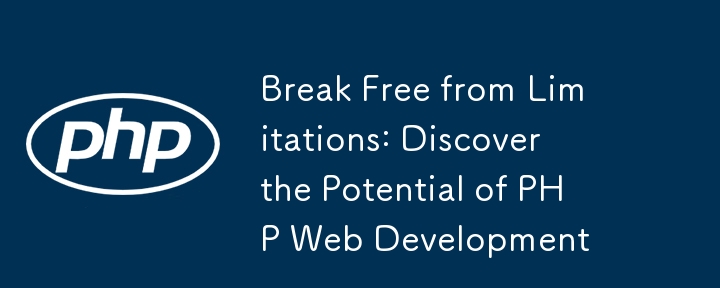Home >Backend Development >PHP Tutorial >Break Free from Limitations: Discover the Potential of PHP Web Development
Break Free from Limitations: Discover the Potential of PHP Web Development
- WBOYWBOYWBOYWBOYWBOYWBOYWBOYWBOYWBOYWBOYWBOYWBOYWBOriginal
- 2024-10-11 10:45:51472browse
PHP is a powerful backend language for creating dynamic, interactive, and scalable web applications. Its advantages include cross-platform compatibility, broad ecosystem, ease of learning, and scalability. Practical case: Building a simple PHP blog requires the following steps: 1. Set up Apache and PHP; 2. Create a database; 3. Connect to the database; 4. Create the structure of the blog; 5. Implement the blog function. With PHP's power and flexible ecosystem, you can push the limits and create stunning web applications.

Breaking Limits: Exploring the Potential of PHP Web Development
PHP is a powerful back-end programming language that is known for its Known for flexibility, ease of use, and broad ecosystem. By leveraging the power of PHP, you can create dynamic, interactive, and scalable web applications.
Advantages of PHP
- Cross-platform compatibility: PHP can run on different operating systems like Windows, Linux, and macOS.
- Extensive Ecosystem: PHP has a large and active ecosystem offering various frameworks, libraries and tools.
- Easy to learn: PHP is known for its simple syntax and comprehensive documentation, even for beginners.
- Scalability: PHP is capable of handling high-traffic applications and scales easily through various optimization techniques.
Practical case: setting up a simple PHP blog
Let us demonstrate the practical application of PHP by creating a simple blog:
1. Set up Apache and PHP
- Install the Apache web server and PHP on your system.
- Configure Apache to parse PHP files.
2. Create a database
- Create a database using a database management system such as MySQL or MariaDB.
- Create a data table containing a table of posts.
3. Connect to the database
- Use PHP to connect to the database.
- Execute queries using database extensions such as MySQLi or PDO.
4. Create the structure of the blog
- Create a main page to display the list of posts.
- Create a detail page for displaying a single post.
- Create an admin page for adding and deleting posts.
5. Implement blog functionality
- Use PHP functions to retrieve posts, create new posts and update existing posts.
- Use HTML and CSS to design and style your blog’s pages.
Results
By following these steps, you will create a fully functional PHP blog that can store, display, and manage posts. This is just a simple example of how PHP's widespread use empowers web development.
By embracing the power and flexible ecosystem of PHP, you can push the limits and create stunning web applications.
The above is the detailed content of Break Free from Limitations: Discover the Potential of PHP Web Development. For more information, please follow other related articles on the PHP Chinese website!

